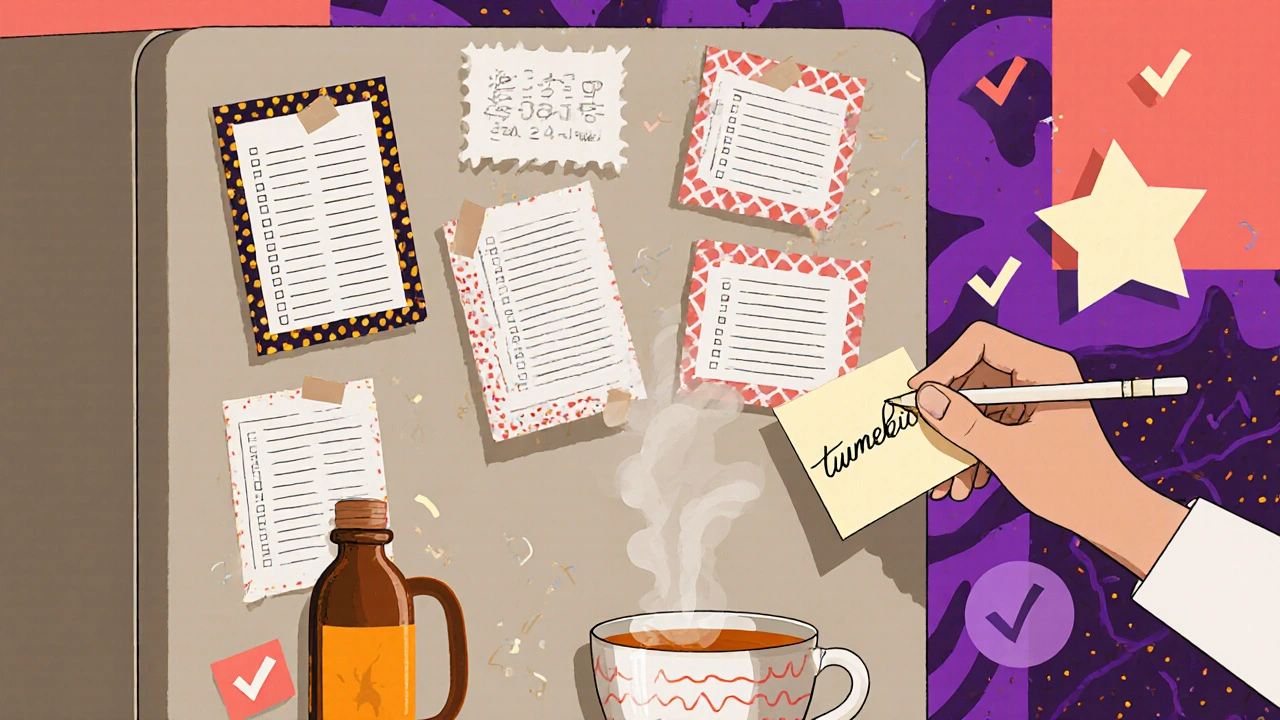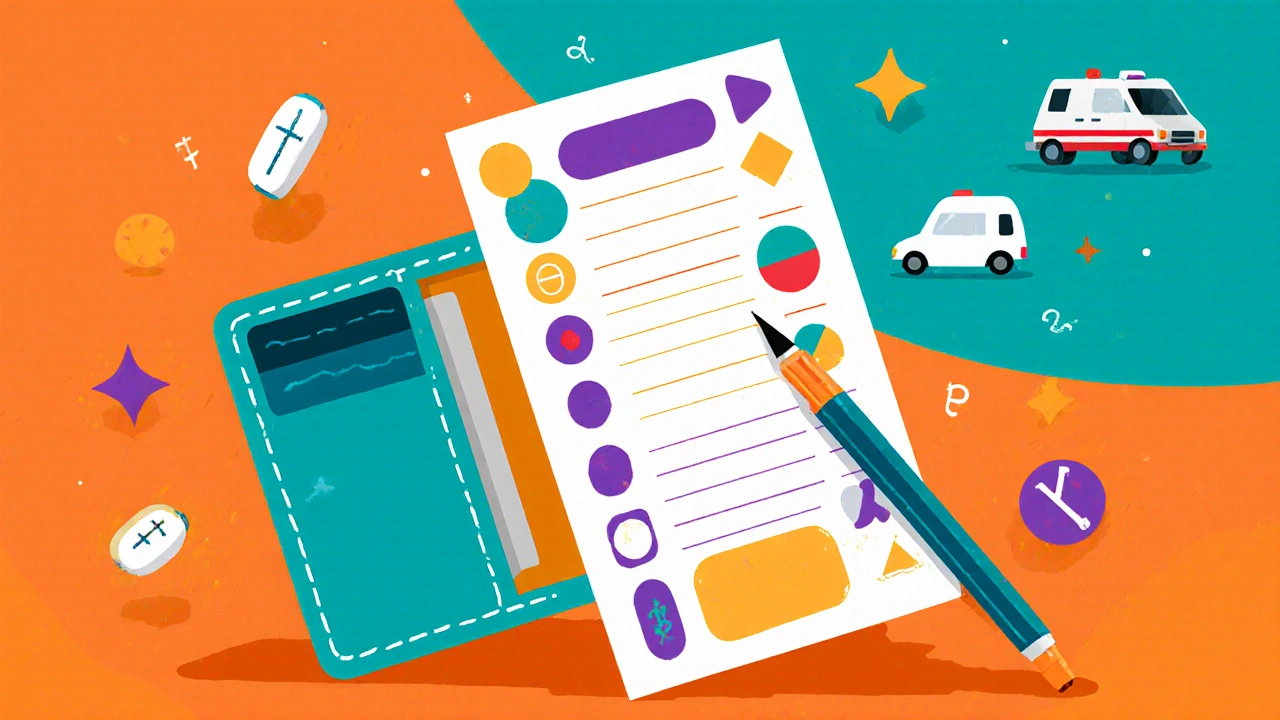Medication List Builder
Your Medication List
Create a complete medication list with all essential fields for safe healthcare management. Include prescription drugs, over-the-counter medications, supplements, and herbal products.
Your Final Medication List
This list contains all the essential information needed for healthcare providers to manage your medications safely.
Keeping track of your medications isn’t just a good idea-it’s a lifesaver. Every year in the U.S., over 1.3 million people end up in the emergency room because of medication errors. Many of those mistakes happen because someone couldn’t remember what they were taking, or their doctor didn’t have the full picture. A simple, up-to-date medication list can prevent dangerous interactions, avoid duplicate prescriptions, and give you control during a medical emergency. The good news? You don’t need an app or a fancy device to get started. Free, reliable templates are out there-printable for your wallet or digital for your phone-and they’re easier to use than you think.
Why a Medication List Matters More Than You Realize
Think about the last time you saw a doctor. Did you bring a list of everything you take? Most people don’t. A 2022 study found that 67% of emergency room patients couldn’t accurately name all their medications. That’s not just inconvenient-it’s dangerous. Imagine being rushed to the hospital after a fall. The paramedics need to know if you’re on blood thinners, or if you’re taking a supplement that could clash with the painkiller they’re about to give you. A printed list taped to your fridge or saved on your phone can make all the difference. The FDA calls medication lists a "must-have" tool. They’re not just for seniors. One in four adults in the U.S. takes at least five prescription drugs. Add in over-the-counter painkillers, vitamins, and herbal supplements-and you’ve got a complex mix that even pharmacists struggle to keep track of without help.What Should Be on Your Medication List?
A good template doesn’t just ask for drug names. It asks for the details that matter. Here’s what to include:- Medication name (brand and generic, if different)
- Dosage (e.g., 10 mg, 500 mg)
- Frequency (e.g., once daily, twice a week)
- Purpose (what it’s for-e.g., "for high blood pressure," "for arthritis pain")
- Prescribing doctor (name and contact info)
- Pharmacy name (where you fill it)
- Allergies and reactions (e.g., "rash from penicillin")
- Supplements and herbal products (many people forget these, but they can interact with prescriptions)
- Notes (e.g., "take with food," "avoid alcohol")
Printable Templates: Simple, Reliable, Always There
Not everyone wants to use a phone app. Maybe you’re older. Maybe you’re not tech-savvy. Maybe you just trust paper better. That’s fine. Printable templates are still the most widely used option. Family Caregivers Online offers a clean, easy-to-use PDF that you can print and carry in your purse or wallet. They also give you a Word version if you want to type it out and edit it later. Their advice? Keep one copy at home, one with your caregiver, and one in your car. Take a photo of it and save it on your phone too. That way, even if you lose the paper, you’ve got a backup. The ASCP Foundation’s template is used by hospitals and clinics across the country. It’s professional, well-organized, and trusted by healthcare providers. You won’t find flashy design here-but you also won’t find missing fields. It’s the gold standard for accuracy. One thing to watch: printed lists get outdated fast. A 2024 Johns Hopkins study found that nearly one in five medication lists brought to appointments had at least one drug that was no longer being taken. That’s why the FDA recommends setting a monthly calendar reminder to review and update your list. Keep a pen next to it. Make it part of your routine, like checking your mailbox.Digital Templates: Editable, Shareable, and Smart
If you’re comfortable with your phone or computer, digital templates are the future. They’re easier to update, and you can share them instantly with doctors or family. SimpleNursing’s drug card templates are popular with caregivers and nursing students. They come in three formats: full page, single flashcard, or four per page-perfect for printing a set to carry in a binder. The best part? They include fields for "mechanism of action" and "nursing considerations." That’s more detail than most patients need, but it’s useful if you’re helping someone else manage their meds. Family Caregivers Online updated their Word template in June 2024 to include a QR code. Scan it with your phone, and the list opens right away. No more digging through files. Just point your camera, and boom-you’ve got your meds in seconds. SingleCare offers five free templates, including a caregiver checklist that tracks when doses are taken. Their user reviews average 4.7 out of 5. But some older users say the layout is too cluttered. If you’re helping a parent or grandparent, stick with the simplest version.What to Avoid
Not all templates are created equal. Here’s what to skip:- Templates with more than 10 fields-they’re overwhelming. A 2024 study found that people stopped updating lists with too many boxes.
- Templates without a "notes" section-you need room to write "take with breakfast" or "causes dizziness."
- Canva templates that look pretty but miss key info-beauty doesn’t save lives. Stick to templates that include dosage, frequency, and doctor info.
- Apps that don’t sync with your pharmacy-if it can’t auto-update when you refill a prescription, it’s just another list you’ll forget to update.
How to Use Your Template (Step by Step)
Getting started is easier than it sounds:- Go to Family Caregivers Online, ASCP Foundation, or CDC’s website. Download the PDF or Word version.
- Gather all your medications: pill bottles, supplement boxes, even that herbal tea you take at night.
- Fill in each field. Write clearly. If you’re unsure of the dosage, call your pharmacy.
- Print two copies. One stays at home. One goes in your wallet or purse.
- Take a photo and save it in your phone’s notes app or cloud storage (Google Drive, iCloud).
- Set a monthly reminder on your phone: "Review meds." When it pops up, check if anything changed.
- Bring the list to every doctor’s appointment-even a quick checkup.
Real Stories: When a List Saved the Day
On Reddit’s r/CaregiverSupport, a user named NanaHelper2023 wrote: "My mom had a stroke last year. The paramedics pulled out the medication list I kept on the fridge. They saw she was on warfarin and skipped the NSAID they were about to give her. That list saved her from internal bleeding." Another caregiver on AgingCare.com said: "I printed five copies. I never updated them. I wish it synced with my phone." That’s the problem with paper. But it’s fixable. A 2023 survey by the Indian Health Service found that 92% of Native American participants appreciated the CDC’s template because it included traditional medicines. That’s not a small detail-it’s cultural respect. And it matters.
What’s Next? The Future of Medication Lists
The FDA is pushing for digital lists to connect directly with electronic health records. By 2026, Gartner predicts 75% of people will manage their meds through apps. But that doesn’t mean printed lists are obsolete. Not yet. Right now, the best approach is a hybrid: keep a printed copy for emergencies, and use a digital version for daily updates. Use the QR code templates. Take photos. Set reminders. Share with your caregiver. The goal isn’t perfection. It’s consistency. Even a basic list, updated every few months, reduces your risk of a dangerous drug interaction. That’s more than most people do.Frequently Asked Questions
What if I take a lot of medications? Will a template still work?
Yes. Most templates have a "notes" section where you can write "5 pills in the morning, 3 at night" or "rotating schedule." You can also print multiple pages or use a digital template that lets you add rows. The key is to include every item-even if it’s just a daily vitamin. Missing one can cause an interaction.
Should I include over-the-counter drugs and supplements?
Absolutely. The American Pharmacists Association says 23% of adults experience harmful interactions between prescription drugs and supplements. That includes things like St. John’s Wort, fish oil, or even common pain relievers like ibuprofen. If you take it, write it down.
Is it safe to store my medication list on my phone?
Yes, if you protect it. Don’t save it in an unsecured note app. Use a password-protected folder, or a trusted app like Apple Notes with Lock Notes enabled. Avoid cloud services that aren’t encrypted. A 2023 breach exposed 12,000 medication lists-so privacy matters. A printed copy is always a safe backup.
Can I use these templates for someone else, like my parent?
Yes. Many templates, especially from SingleCare and Family Caregivers Online, are designed for caregivers. You can fill out the list on their behalf. Just make sure the person knows it’s there, and that you update it when they change meds. If they’re unable to manage it themselves, keep a copy with you at all times.
How often should I update my medication list?
At least once a month. Set a reminder on your phone. Also update it immediately after any change: a new prescription, stopping a drug, or switching pharmacies. A 2024 study showed that people who updated their list monthly were 60% less likely to have a medication error than those who updated it only once a year.
Do I need to bring the list to every doctor visit?
Yes-even for a flu shot or a skin check. Doctors often don’t have access to your full history, especially if you see multiple specialists. Having your list on hand prevents duplicate prescriptions and helps them spot potential interactions. It’s the easiest way to make sure you’re getting the right care.

